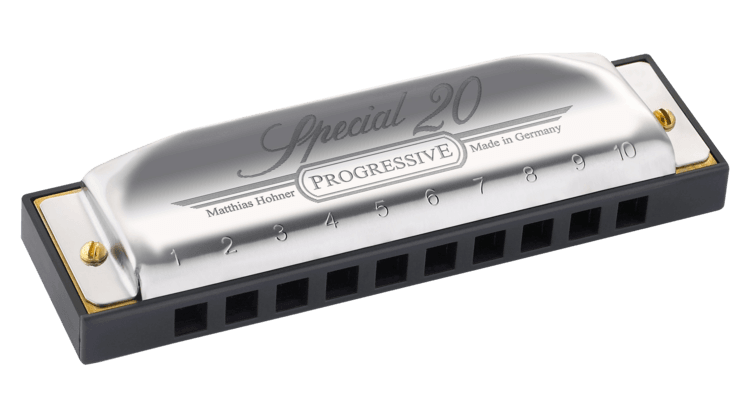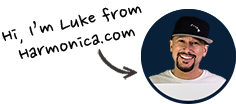You want to learn your favorite song on harmonica, you’ve found the harmonica tabs for it, and you’ve got your diatonic C harmonica. You’re all ready to play the song, right? But wait a second, how the heck do you even read harmonica tabs?!?
The holes on the 10-hole diatonic harmonica are numbered from 1 on the left, the lowest in pitch, to 10 on right, the highest in pitch.

Harmonica tablature is really quite simple:
A number alone indicates which hole to blow
4 means blow hole number 4
1 means blow hole number 1
12 means blow holes number 1 & 2 at the same time (aka double-stop.)
123 means blow holes number 1, 2, & 3 at the same time (aka chord.)
Example: Under Pressure / Ice Ice Baby
4 4 4 44 4 3 4 4 4 4 44 4 3
Here is the jam track without harmonica for you to play along with.
A minus sign followed by number indicates which hole to draw
-4 means draw on hole number 4
-1 means draw on hole number 1
-12 means draw holes number 1 & 2 at the same time (aka double-stop.)
-123 means draw holes number 1, 2, & 3 at the same time (aka chord.)
Example: Reveille, aka The Wakeup Call
-1 -2 -3 -2 -1 -3 -2 -3 -2 -1 -3 -2 -3 -2 -1 -2 -3 -2 -1 -2 -3 -2 -1 -3 -2 -3 -2 -1 -3 -2 -3 -2 -1 -1 -2
And that’s all you need to know to be able to play beginner songs on the harmonica! Now let’s try the first 4 lines from Take Me Home Country Road.
4 -4 5 5 4 -4 5 -4 4 5 6 -6
Here is the jam track without harmonica for you to play along with.
To play many songs, especially blues songs, an intermediate and advanced technique called bending is required. Bending is a technique that lowers the pitch of a note. Harmonica tabs indicate bends like this:
An apostrophe after a number indicates a half-step bend
-3’ indicates a draw 3 bent down a
half-step (very common)
-3’’ indicates a draw 3 bent down a
whole-step (common)
-3’’’ indicates a draw 3 bent down a
step and a half (uncommon)
And likewise for blow bends:
10’ indicates a blow 10 bent down a half-step
10’’ indicates a blow 10 bent down a whole-step
Example: Funkin’ Up All The Bends
-1 -2” -2’ -2 -3” -3’ -3 -4 5 -4 -5 5 -3’ -2 -2 -2’ -2” 2 3 -3''' 3 -3’’’ -3 -4’ 5 5 6 -6’6 -6’ -7 6 -6’ 8 -8 -8’ -8 -8 8 -9 9’ -10 -9 9’ -8 7 -8 8’ 8 9 8’ 8 7 10 10” 10’ 9 2 -2” -1 -2 -3’ -9 9 -9 8 9 8 8’ 9 8’ -8 1 -1’ -1 -56 (trill) -1 -2” -2’ -2 -3” -3’ -3
Here is the jam track with and without the harmonica for you to play along with.
Bending is not a Beginner Technique
Please note that bending is not a beginner technique. I recommend first learning the deep relaxed mouth position, and then how to isolate notes using the lip blocking technique. Once you’ve mastered those techniques, then I recommend beginning to learn how to bend. When you start working on bending, don’t forget to check out our Bend-It-Better tool to help you along your journey!
Harp Tabs – the Good & the Bad
Harmonica tabs simply tell you which hole number(s) to play, and they give you the order that those notes come in for a given song. Harmonica tabs don’t tell you the rhythm of these notes, so the tabs will be most helpful to learn to play a song that you already have heard many times, and that you know well. You can be sure that if you can sing the song, then harmonica tabs could be a very helpful tool in learning to play the song on the harmonica.
Other Harmonica Tablature
Once you’ve gotten the hang of the deep relaxed mouth position, isolating notes using lip blocking, and beginning to bend, you may also decide to explore the tongue-blocking method of isolating notes, and the accompanying palette of sounds that it offers such as octaves, slaps, flutters, shimmers, rapid chord vamps, and split shakes. (By the way, I teach an introduction to all of these techniques in my course Harmonica Beginner to Boss.)
Tongue-blocking teachers may have another set of symbols that they will add, such as a small circle above a number to indicate a tongue slap. Again, tongue-blocking is not a beginner technique, and teachers who specialize in this advanced technique will tell you what their symbols mean. In my course, I just write the name of the technique on the screen, or in the case of octaves (aka splits) you’ll just see -14 for an octave where you are drawing on holes 1 and 4 with your tongue covering holes 2 & 3.
Here at harmonica.com, we are dedicated to playing and teaching the wonderful, simple, inexpensive, 10-hole diatonic harmonica. The chromatic harmonica is a totally different instrument, and is not our emphasis here. However, FYI, parentheses in harmonica tablature that is written for a chromatic harmonica indicates pushing in the button. So (4) would mean playing a blow 4 with the slide button pushed in.
And that’s everything you ever wanted to know about harmonica tablature, and probably more! If you have any other questions about harmonica tabs, just drop a comment below.
Luke

Comments
Got something to say? Post a comment below.